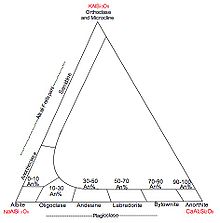Coupled substitution is the geological process by which two elements simultaneous substitute into a crystal in order to maintain overall electrical neutrality and keep the charge constant.[1] In forming a solid solution series, ionic size is more important than ionic charge, as this can be compensated for elsewhere in the structure.[2]

replaces Si4+
and Ca2+
for Na+
Ionic size
editTo make a geometrically stable structure in a mineral, atoms must fit together in terms of both their size and charge. The atoms have to fit together so that their electron shells can interact with one another and they also have to produce a neutral molecule. For these reasons the sizes and electron shell structure of atoms determine what element combinations are possible and the geometrical form that various minerals take. Because electrons are donated and received, it is the ionic radius of the element that controls the size and determines how atoms fit together in minerals.[3]
Examples
edit- Coupled substitutions are common in the silicate minerals where Al3+
substitutes for Si4+
in tetrahedral sites.[4]
For example, when a plagioclase feldspar solid solution series forms, albite (Na Al Si3O8) can change to anorthite (Ca Al2Si2O8) by having Al3+
replace Si4+
. However, this leaves a negative charge that has to be balanced by the (coupled) substitution of Ca2+
for Na+
.[2]
- Despite being nicknamed fool's gold, pyrite is sometimes found in association with small quantities of gold. Gold and arsenic occur as a coupled substitution in the pyrite structure. In the Carlin–type gold deposits, arsenian pyrite contains up to 0.37% gold by weight.[5]
- The possible replacement of (Al3+)2 by Fe2+Ti4+ in Corundum.[1]
- NiO and TiO
2 in Haematite[6] - Ca2+
Mg2+
→ Na+
Al3+
Diopside (MgCaSi2O6) → Jadeite: (NaAlSi2O6 or Na(Al,Fe3+
)Si
2O
6)[4]Diopside can be converted into Jadeite by coupled substitution - Mg2+
2Al3+
→ 2Fe2+
Ti4+
As in the Spinel groups[4] - The site being filled to maintain charge does not have to be a substitution. It can also involve filling a site that is normally vacant in order to achieve charge balance. For example, in the amphibole mineral Tremolite - (Ca2(Mg5.0-4.5Fe2+0.0-0.5)Si8O22(OH)2), Al3+
replaces Si4+
then Na+
can go into a site that is normally vacant to maintain charge balance. This new mineral would then be edenite (NaCa
2Mg
5(Si
7Al)O
22(OH)
2 a variety of hornblende.[4] - Bityite’s structure consists of a coupled substitution it exhibits between the sheets of polyhedra; the coupled substitution of beryllium for aluminium within the tetrahedral sites allows a single lithium substitution for a vacancy without any additional octahedral substitutions.[7] The transfer is completed by creating a tetrahedral sheet composition of Si2BeAl.[8] The coupled substitution of lithium for vacancy and the beryllium for the tetrahedral aluminium maintains all the charges balanced; thereby, resulting in the trioctahedral end member for the margarite sub-group of the phyllosilicate group.[8]
- Ferrogedrite is related to anthophyllite amphibole and gedrite through coupled substitution of (Al, Fe3+) for (Mg, Fe2+, Mn) and Al for Si.[9]: 12–78
References
edit- ^ a b "Coupled Substitution -- from Eric Weisstein's World of Chemistry". Archived from the original on 2019-03-25. Retrieved 2019-03-26.
- ^ a b Allaby, Michael (2013-07-04). A Dictionary of Geology and Earth Sciences. OUP Oxford. ISBN 9780199653065.
- ^ Langmuir, Charles Herbert; Broecker, Wallace S. (2012). How to Build a Habitable Planet: The Story of Earth from the Big Bang to Humankind. Princeton University Press. ISBN 9780691140063.
- ^ a b c d "Tulane course". Archived from the original on 2017-07-09. Retrieved 2019-03-26.
- ^ Fleet, M. E.; Mumin, A. Hamid (1997). "Gold-bearing arsenian pyrite and marcasite and arsenopyrite from Carlin Trend gold deposits and laboratory synthesis" (PDF). American Mineralogist. 82 (1–2): 182–193. Bibcode:1997AmMin..82..182F. doi:10.2138/am-1997-1-220. S2CID 55899431. Archived (PDF) from the original on 2017-08-10. Retrieved 2019-03-27.
- ^ Park, B. -H.; Suito, H. (1993). "Coupled substitution of NiO and TiO2 in haematite". Journal of Materials Science. 28 (1): 52–56. Bibcode:1993JMatS..28...52P. doi:10.1007/BF00349032. S2CID 97048742.
- ^ Lin, J-C. and Guggenheim, S. (1983). "The crystal structure of a Li,Be-rich brittle mica: a dioctaheral-trioctahedral intermediate". American Mineralogist, 68, 130-142.
- ^ a b Guggenheim, S. (1984). "The brittle micas". Reviews in Mineralogy, 13, 61-104.
- ^ Deer, William Alexander, Robert Andrew Howie, and Jack Zussman (1997). Rock-forming minerals. 2B. Double-chain silicates, Vol. 2. Geological Society.